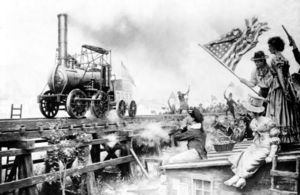Stourbridge Railroad
| Stourbridge Railway | |
|---|---|
| Reporting marks | SBRR |
| Locale | Pennsylvania |
| Dates of operation | 1977 – present |
| Track gauge | 4 ft 8½ in (1435 mm) (standard gauge) |
| Headquarters | Honesdale, Pennsylvania |
The Stourbridge Railroad (AAR reporting marks SBRR) is a short line that operates 24 miles of track between Honesdale (in Wayne County, Pennsylvania in the United States) and the village of Lackawaxen in Lackawaxen Township (in Pike County, Pennsylvania). It is owned by the Lackawaxen-Honesdale Shippers Association and operated under contract by Robey Railroads.
Hawley (in Wayne County) is also served by the line, which runs southeast from Honesdale to Hawley, then east to Lackawaxen. At Lackawaxen (which is on the border with New York), there is a connection to the Norfolk Southern Railway line. CSX Transportation rail service is also available via this track (as well as an indirect connection to Canadian Pacific Railway service).
Tourist excursions
The Wayne County Chamber of Commerce offers excursions on the line that take its passengers back through time in old refurbished railroad cars from Honesdale (on Pennsylvania Route 191) to Hawley. The railroad has restored and refurbished 5 passenger cars that are on display and an old fashioned snow plow is also on display.
History

According to the Wayne County Chamber of Commerce, this is the site of "the first commercial locomotive on rails in the western hemisphere", run by the Delaware and Hudson railway on August 8, 1829. The locomotive was the famous Stourbridge Lion.
In 1868, the line became part of the Jefferson Railroad, and part of the Erie Railroad in 1870. In 1960 the Erie's successor merged with the Delaware, Lackawanna and Western Railroad to form the Erie Lackawanna Railroad, becoming part of Conrail in 1976. Conrail announced plans to abandon the line in 1976, and the Lackawaxen-Honesdale Shippers Association was formed, taking over in 1977.
The line was washed out in 2005, with the break occurring at Hawley.
See also
- List of Pennsylvania railroads
- North Shore Railroad (also operated by Robey Railroads)
External links
- Lackawaxen-Honesdale Shippers Association "Rail Service Availability on the Stourbridge Railroad"
- Wayne County Chamber of Commerce Stourbridge Rail Line Excursions
- North East Rails - Unofficial North Shore, North East Pennsylvania Shortline Website
- Railroad.Net 'Consolidation of Robey-owned lines under one name' Discusses line break
- North Shore Railroad System Map showing the Stourbridge Railroad
- Pennsylvania Department of Transportation 2004 Railroad Map of Pennsylvania (shows owners and operators)
